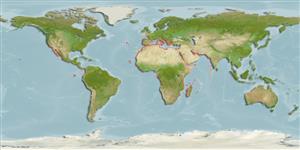Branchiopoda |
Anostraca |
Artemiidae
Environment: milieu / climate zone / depth range / distribution range
Ecology
Pelagic-neritic; brackish; depth range 0 - 2 m (Ref. 80843). Tropical, preferred 23°C (Ref. 107945); 52°N - 35°S, 123°W - 75°E
Circumglobal.
Length at first maturity / Size / Weight / Age
Maturity: Lm ? range ? - ? cm Max length : 1.5 cm TL male/unsexed; (Ref. 101378)
Inhabits extreme environments such as salt lakes or brine waters, coastal or inland (Ref. 105262), just like saline lakes, and coastal salterns (Ref. 105501). Its nauplii is an irreplaceable live feed for marine and shrimp larvae. Latent eggs cysts are known to withstand long drought periods at severe hypersalinity (Ref. 105261). In an experiment, adults are fed with the dinoflagellate Gyrodinium corsicum and Cryptophyta Rhodomonas baltica (Ref. 105262).
Life cycle and mating behavior
Maturity | Reproduction | Spawning | Eggs | Fecundity | Larvae
Reproduction mode may be oviparous or oviviparous, depending on environmental conditions. Copulation is present. Life cycle: Eggs may either develop into nauplia (larvae) or may stay as cysts (dormant) to survive the drought period before hatching into nauplia.
Bisby, F.A., M.A. Ruggiero, K.L. Wilson, M. Cachuela-Palacio, S.W. Kimani, Y.R. Roskov, A. Soulier-Perkins and J. van Hertum 2005 Species 2000 & ITIS Catalogue of Life: 2005 Annual Checklist. CD-ROM; Species 2000: Reading, U.K. (Ref. 19)
IUCN Red List Status
(Ref. 130435: Version 2025-1)
CITES status (Ref. 108899)
Not Evaluated
Not Evaluated
Threat to humans
Human uses
Fisheries: commercial; aquaculture: commercial
FAO - Aquaculture: production; Fisheries: landings | FishSource | Sea Around Us
Tools
More information
Trophic EcologyFood items (preys)
Diet composition
Food consumption
Predators
Life cycleReproductionMaturityFecunditySpawningEggsEgg developmentLarvae PhysiologyOxygen consumption
Human RelatedStamps, coins, misc.
Internet sources
Estimates based on models
Fishing Vulnerability
Low vulnerability (10 of 100).
Climate Vulnerability
High vulnerability (56 of 100).
Price category
Unknown.
Nutrients : Calcium = 126 [75, 177] mg/100g; Iron = 4.79 [1.67, 7.92] mg/100g; Protein = 16.6 [15.4, 17.8] %; Omega3 = 0.331 [0.263, 0.400] g/100g; Selenium = 57.8 [48.5, 67.2] μg/100g; VitaminA = 0 μg/100g; Zinc = 1.97 [0.92, 3.02] mg/100g (wet weight); based on
nutrient studies.
